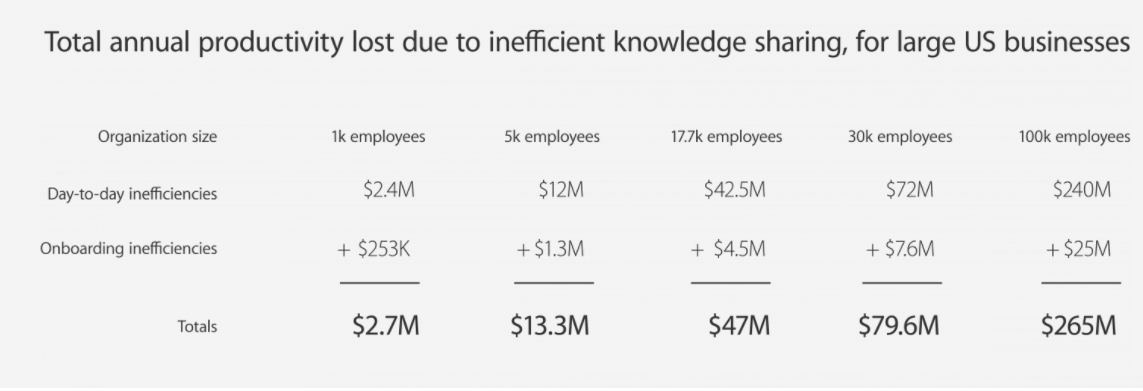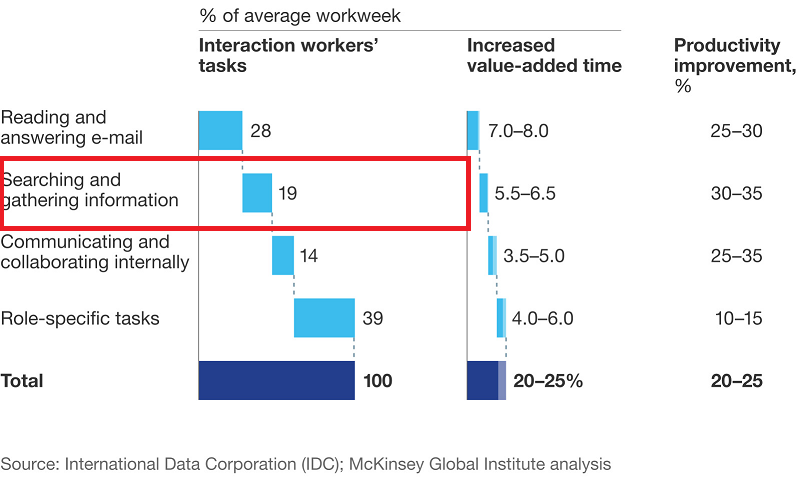
Knowledge sharing is the process of sharing organizational knowledge with other members within your company. It's a critical aspect of the knowledge management process as knowledge sharing enables the exchange, creation, and preservation of knowledge and expertise within an organization.
Why does this matter?
Because, the collective knowledge possessed by all the members within your organization is one of your company’s most valuable assets.
It’s what enables your individual employees to do their job well.
It’s what ensures your overall operations run smoothly and effectively.
It also provides your business with a competitive edge.
Overall, it’s what separates your business from other businesses — and what allows you to provide value to your customers in the way you do. In fact, according to Deloitte's Human Capital Trends report, 75% percent of organizations that were surveyed believed that creating and preserving knowledge was important to their success.
Of course, your team’s collective knowledge can only become collective if your employees actively and consistently share it with one another.
Unfortunately, it can be very difficult to persuade your employees to share their knowledge – especially if you don’t have the right culture in place first. The failure of creating and implementing a knowledge sharing culture is high, as the average US-based business loses anywhere from $2.7 million to $265 million in productivity (depending on size) each year due to inefficient sharing of knowledge.
 (Source)
(Source)
In this article, we’ll be looking at:
- What knowledge sharing is
- Why it's important to encourage knowledge sharing in the workplace
- Common barriers that negatively impact knowledge sharing in the workplace
- Types of knowledge sharing
- How to improve knowledge sharing in the workplace
So whether you're a manager looking to promote knowledge sharing within your team, or an individual looking to learn from your colleagues and contribute to the success of your organization, this post will help you get started on your journey.
What is Knowledge Sharing?
Knowledge sharing is the process of exchanging information, ideas, and experiences among individuals or groups. It involves sharing knowledge and expertise within an organization or team, as well as with external stakeholders. It's a key component in knowledge management because it enables knowledge transfer and expertise from individuals and teams within an organization, which can help to build a collective knowledge base. In turn, this helps to enable a culture of organizational learning and can help to build a culture of continuous improvement and innovation.
Knowledge sharing can help with facilitating the following three types of knowledge: tacit, explicit, and implicit.
- Tacit knowledge is knowledge that is difficult to express or communicate in words, such as personal experiences, insights, and skills. Tacit knowledge is often shared through face-to-face interactions, such as mentorship or on-the-job training, which allow individuals to learn through direct observation and experience.
- Explicit knowledge is knowledge that can be easily documented and shared, such as facts, procedures, and processes. Explicit knowledge is often shared through written documents, presentations, and formal training programs.
- Implicit knowledge is knowledge that is embedded in the practices, processes, and culture of an organization. Implicit knowledge is often difficult to identify and capture, but it can be shared through shared experiences, traditions, and cultural practices.
We will discuss several strategies that you can utilize to make knowledge sharing more effective in the workplace, but before we do that, let's discuss why you should care about improving the sharing of knowledge as well as some typical barriers you may encounter.
Benefits of Encouraging Knowledge Sharing in the Workplace
The purpose of knowledge sharing is to increase the collective knowledge and understanding of a group or organization, which can lead to improved decision making, problem solving, and innovation.
The thing is, investing in the facilitation of knowledge sharing is a commitment. The free and consistent exchange of knowledge does not occur overnight, nor does it begin out of the blue. It takes concerted effort and intentionality.
The work is well worth the reward, though. There are innumerable benefits to knowledge sharing and ways in which it is vital to your team’s success.
1. Improves Organizational Alignment
While retaining individuality is integral to a diverse, happy workforce, it's important that employees are aligned with your company's mission and overall goals. Having your employees aligned with your goals, mission, and values help to create cohesion and boost engagement at work.
Without knowledge sharing, organization alignment simply cannot be reached. Employees must be on the same page always, and the only way for that to happen is for knowledge to be shared on a consistent basis. This keeps everyone informed, in tune with company-wide values, and so on. It also keeps everyone focused on the current project or goal.
2. Increases Productivity

Employees spend nearly 20% of the working week searching for information they need to do their jobs. Let that sink in for a moment. This means your employees are wasting one-fifth of their time looking for knowledge that should be readily available.
By making knowledge easily accessible and found, your employees can spend more time focusing on their work as opposed to trying to find the information they need to do their job. Not only that, but by improving the sharing of knowledge, you make it much easier to keep all employees informed at all times. In turn, your employees can be more effective and efficient at their jobs, which leads to improved productivity.
3. Enhances Knowledge Retention
The retention of knowledge on an individual level is vital to the performance of that individual. However, when working in a team environment, everyone must have the same knowledge. A single mistake can lead to team-wide setbacks and reduced performance.
To ensure this does not happen, the entire team needs to retain pertinent information. By sharing knowledge and expertise, organizations can identify and capture valuable knowledge and store it in a structured and organized way. This can make it easier for team members to access and retain the knowledge they need to do their jobs effectively.
Additionally, when employees are encouraged to share their knowledge and expertise with others, it creates a cycle where the employees are encouraged to apply the knowledge they have acquired in their work, which can help to reinforce their understanding and retention of the material that's been shared.
4. Enhances Communication and Collaboration
Knowledge sharing plays a crucial role in enabling communication and collaboration within an organization. By providing a platform for the exchange of knowledge and expertise, organizations can improve communication and collaboration among team members and departments, and across different levels of the organization. This can help to break down silos and encourage cross-functional teamwork, which can improve the efficiency and effectiveness of business processes.
In addition, knowledge sharing can enable communication and collaboration with external stakeholders, such as customers, partners, and suppliers. By sharing knowledge and expertise with these stakeholders, organizations can build strong relationships and improve their ability to work together to achieve common goals.
5. Helps Your Company Save Money
You can save money by reducing duplicate efforts as well as reducing the amount of time that employees spend searching for information. For example, when Intel was trying to improve the performance of one of its products, the company discovered that 60% of problems it was encountering had already been solved by a previous team.
6. Increases Job Satisfaction and Employee Retention
While knowledge retention is exceptionally effective in creating a cohesive workforce, it also encourages employees to be more autonomous by empowering them to perform with confidence.
When autonomy is achieved, employees are more satisfied with their jobs, more likely to take control of their daily operations, and placed solidly in control of their career development. When these factors coalesce, there is an increased likelihood that employees will stick with your company for the foreseeable future.
Furthermore, knowledge sharing can help to create a culture of continuous learning and improvement, which can help with improving employee motivation and therefore employee retention.
7. Enables Competitive Edge Through Innovation
Knowledge sharing encourages the exchange of ideas and perspectives, which can stimulate innovation and creativity. By fostering a culture of continuous learning and improvement, organizations can encourage employees to think creatively and come up with new ideas and solutions, enabling organizations to sustain a competitive edge.
Furthermore, fostering a culture of continuous learning and improvement, organizations can ensure that they are up-to-date with the latest industry trends and best practices, and can continuously adapt and innovate to meet the changing needs of their customers.
Barriers to Knowledge Sharing
There is no shortage of evidence that knowledge sharing is integral to a healthy and successful work environment. Encouraging knowledge sharing and implementing policies that facilitate it are necessary to foster such an environment and elevate your company culture.
However, with great potential come significant barriers that must be overcome. In order to develop a plan for creating the knowledge-sharing network you envision, you must first understand the barriers between those plans and reality.
1. Knowledge Silos
While the term knowledge (or information) silo may prompt fascinating mental pictures and remind you of the classic farm landscape present across middle America, the reality is far removed from these idyllic scenes. Siloing of knowledge or information is a significant threat to your organization.
So, what are these information silos, and why are they so damaging?
Imagine you are back in high school. Everyone gravitates to their own distinct cliques. Within those cliques, things are good—people get along, they work well together, and it is mostly smooth sailing. When forced to work together, however, the various social groups are almost entirely incompatible.
The same dynamic can exist within a company. Instead of football players, art students, metalheads, and so forth, though, you have the various departments within your organization. Each of these departments has its own culture, knowledge, and mentality. When you try to blend the departments—a necessity when it comes to knowledge sharing—the friction is obvious, and productivity grinds to a halt due to these organizational silos.
Of course, this isolationist mentality is almost never intentional. Instead, it occurs naturally as the departments focus on their unique goals, and communication with other departments takes a backseat. Because knowledge silos are naturally occurring, it is even more important to take intentional steps to counteract them.
2. Knowledge Hoarding
While knowledge silos typically form unintentionally, knowledge hoarding is the complete opposite. This barrier to knowledge sharing occurs when employees within your organization purposely do not share critical information.
This may sound like a rare or unusual occurrence, but the truth is that this is a relatively normal phenomenon that many companies encounter. As such, it is vital to get to the root of why employees are keeping crucial information to themselves.
There are three main reasons why employees tend to knowledge hoard—competition, fear, and leverage. Often, these motivations can be traced back to something within your organizational culture that unintentionally encourages such behavior.
For example, an employee may want to gain an edge over their peers in order to score a personal victory. They may fear a negative reaction to their contribution in the workplace. They may even hold onto information in order to make themselves irreplaceable in their position.
3. Lack of Opportunity
As remote work grows more common, a new barrier to knowledge sharing has arisen—a severe lack of opportunity due to limited social interaction. Traditionally, employees have had the opportunity to mingle, chat, and exchange information on both a casual and professional basis. From the cliché water fountain forum to the official meeting space, social interaction was ever-present and conducive for sharing.
Now, more and more team members are working from home. By default, this means fewer chance encounters, social interactions, and unabated knowledge sharing. It is not that they are knowledge hoarding or that information silos are popping up at random; rather, it is that they simply do not have the opportunity to freely connect with their peers like they would in a traditional office setting.
Types of Knowledge Sharing That Occurs in the Workplace
There are several ways that knowledge typically gets shared in the workplace.
1. Formal Training Programs
These are structured training programs that are designed to teach specific skills or knowledge to employees. They can be conducted in-person or online, and may be provided by internal trainers or external experts.
2. Mentorship
This involves a more experienced employee sharing their knowledge and expertise with a less experienced employee. The mentee can learn through observation, asking questions, and receiving guidance and feedback.
3. Collaboration
This involves working with others to share knowledge and ideas in order to achieve a common goal. This can take place through team meetings, group projects, or informal discussions.
4. Use of Knowledge Management Software
There are many knowledge management tools that can facilitate the sharing of knowledge in the workplace, such as online collaboration platforms, social media, knowledge base software, and intranet systems.
5. Informal Knowledge Sharing
This refers to the spontaneous sharing of knowledge that occurs informally and spontaneously in the workplace. It may happen during casual conversations, team lunches, or other informal settings.
Best Practices to Encourage Knowledge Sharing in the Workplace
The advantages of encouraging knowledge sharing should be clear. Knowledge sharing is essential to a healthy, successful company in the modern world. The problem is overcoming the barriers we mentioned above which pose some very real challenges to unlocking the full potential of your company and your team.
How, then, do you go about facilitating knowledge sharing and unlocking the full potential of your organization?
Every company is different, and your approach should be tailored to your unique organizational environment. That being said, there are a few easy ways to kickstart knowledge sharing within your workplace.
1. Build a Culture That Promotes Knowledge Sharing
Unfortunately, almost a third of companies rate their knowledge sharing culture as a 5 or below on a 10 point scale which begs the question: how do you create a company culture that promotes knowledge sharing?

(Source)
Thankfully, it is quite simple—though not without a clear goal and a lot of hard work. You must have a clear mission and vision for your company on which to focus, establish a common mindset of growth throughout your organization, and instill a sense of community among your employees.
Moreover, it's important to remember that knowledge sharing is about building relationships and fostering collaboration between people. For example, communities of practice (skill sharing) or communities of excellence (sharing best practices) are a great way to help build a culture of knowledge sharing.
When a culture of sharing knowledge is embraced and integrated into the very DNA of your company, it becomes much easier to get employees to continuously share what they know as it becomes a way of being for your business.
2. Make it Easy to Share and Preserve Knowledge
Culture is merely a concept unless it is given the tools to be put into action. You can have grand plans for your company, including a vision of a culture built on the free exchange of information, but without the proper resources, these plans will largely remain dreams.
As such, you need to enable your employees to effectively and efficiently share the knowledge they possess. This means providing them with channels, platforms, and spaces that facilitate the sharing of knowledge on a routine basis. By establishing multiple avenues of knowledge sharing, you give employees the flexibility and opportunity to communicate without any roadblocks. In the modern world where remote work is becoming more common, the availability of multiple communication channels is even more essential.
Knowledge sharing should be able to take place both freely and in an organized manner. While your employees should exchange information readily throughout the day, scheduling times to share knowledge via check-ins, weekly meetings, and so on, is a fantastic idea.
Accompanying this communication should be the preservation of the knowledge being shared. Often referred to as knowledge assets, storing information that can be accessed and shared over time is vital to the longevity of a company and the persistence of its knowledge.
Emerging technology takes center stage when it comes to both facilitation and preservation of knowledge sharing. When these tools are implemented on an organizational level, the ease with which information transfer and storage takes place further encouraged employees to embrace knowledge sharing.
3. Centralize Your Knowledge to Create a Single Source of Truth
Sometimes referred to as creating a single source of truth (SSoT), centralizing your organization's accumulated knowledge in a manner that is accessible to all team members at all times—even when knowledge sharing is not taking place in real-time—allows for the unhindered spread of knowledge while ensuring that the knowledge is accurate, well-organized, and up to date.
This is where technology and creating a knowledge sharing system comes into play.
“Knowledge Sharing Systems support the process through which explicit or tacit knowledge is communicated to other individuals. These systems are also referred to as knowledge repositories,” says Sirje Virkus, faculty member at the Institute of Information Studies, Tallinn University.
Here’s a table highlighting the different types of knowledge you might be dealing with:
Knowledge type |
Definition |
Characteristics |
Explicit knowledge |
Knowing |
No room for doubt |
Implicit knowledge |
Action |
Practical and task-based |
Tacit knowledge / Tribal knowledge |
Wisdom |
Subjective and comes with experience |
While there are several types of knowledge management tools that you can use for your single source of truth, if you want to make it truly easy for individuals to share knowledge, then using knowledge base software to create an internal knowledge base would be the most beneficial.
The best knowledge base platforms includes many of the same features offered by corporate wikis, however they are equipped with so much more.
With a knowledge base you can also:
- Limit control access to certain employees to ensure that only those with the proper privileges can access or edit knowledge content
- Make it easy for users to find the information they need when they need it due to the superior search functionality and structure of a knowledge base
- Have access to detailed analytics which will allow you to better understand how knowledge is being shared and what improvements you can make
As we mentioned at the beginning of this section, effectively sharing knowledge means that all knowledge assets need to be easily accessible to those who need it and at all times. The first step in doing so is creating a single digital space to house any and all knowledge that flows through your organization.
An example of how you can use an internal knowledge base for your knowledge sharing system includes sharing explicit knowledge such as training manuals, standard operating procedures, process documentation, and explanatory conceptual articles. You could also use a knowledge base for sharing tacit knowledge in video format to show step-by-step tutorials on how to complete a particular task.
4. Define Roles
A culture of knowledge sharing thrives when each employee actively participates in it. Every team member, by default, has a role, and that role is to constantly be seeking to both share and received knowledge.
However, there are times where a more intentional, targeted approach must be used to push those efforts forward. Whether it is addressing an area of need or the creation of a specific learning initiative, a need for defined roles within your knowledge-sharing initiatives sometimes arises.
For example, training sessions often require someone in the role of “expert” to share knowledge with “learners.” While this is in line with the overall company culture, it typically involves a more formal setting and defined roles. The same is true of onboarding, during which new hires learn from experienced mentors.
When more intentional knowledge-sharing initiatives are implemented, defined roles are required. This is just one more way to continue and strengthen the knowledge-sharing culture you are striving to establish.
5. Standardization of Knowledge Sharing Workflows
Facilitating knowledge sharing through diverse channels is key to encouraging the free flow of ideas and information throughout your company. Documentation, delivery, intake, demonstration, and knowledge improvement are all key processes within the broader culture.
If these steps are taken in a disorganized manner, however, the knowledge sharing that does occur is not optimized. To ensure that the efforts of your team do not go to waste, there must be a consistent, strategic approach every time they share knowledge.
Standardizing the processes through which knowledge is shared in the workplace eliminates any discrepancy and ensuing confusion. Every company’s workflow will be unique, but there are a few key guidelines that can inform the creation of your standard operating procedures. You may want to establish the following, as a start.
- Clarify what knowledge is needed and should be shared.
- Know who is involved in the sharing process and what their role is.
- Standardize how knowledge should be shared and received.
- Make clear how the successful reception of knowledge can be confirmed.
- Define the procedure for when knowledge is not transmitted successfully.
Keep in mind that, while having standardized processes is important, you should not create a rigid work environment—this serves only to stifle new ideas and discourage free movement of information. Instead, the goal should be to integrate certain guidelines and intentionality into the natural flow of knowledge.
6. Encourage and Reward Effort
Enabling knowledge sharing is one thing; encouraging employees to actively participate in it is another thing entirely. While many team members will put forth effort based purely on their investment in the company’s culture and a desire to both grow and thrive in their work environment, creating an ecosystem that recognizes, acknowledges, and celebrates knowledge sharing efforts will offer positive reinforcement to some and inspiration to others.
In other words, you want to foster intrinsic motivation by rewarding employees for a job well done. Sometimes, though, extrinsic motivation may also be required. You can incentivize further knowledge sharing and increased effort by offering tangible rewards to those who excel or who strive to better the company’s culture. From small gifts to financial rewards, extrinsic motivation is often a fantastic complement to intrinsic.
Wrapping Up
No matter how you approach knowledge sharing within your company, one thing is certain—success is contingent on your employees as well as the technology you use to effectively and efficiently share knowledge in an optimized manner. Thankfully, there are modern innovations that can help facilitate the ability to share knowledge more fluidly than ever before.
By creating a comprehensive knowledge base with Helpjuice, knowledge sharing on a personal and organizational level is simple, streamlined, and centralized. From recognizing hard work to maximizing the efficiency with which information is shared, stored, and accessed, Helpjuice’s comprehensive approach to knowledge sharing is the ultimate facilitator of the company culture you envision.





